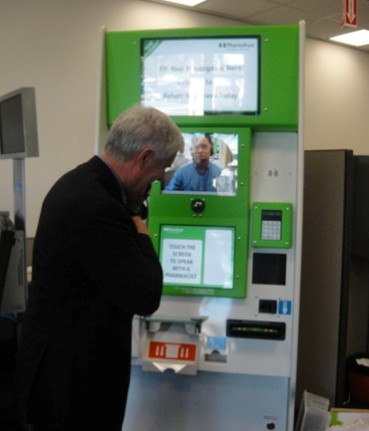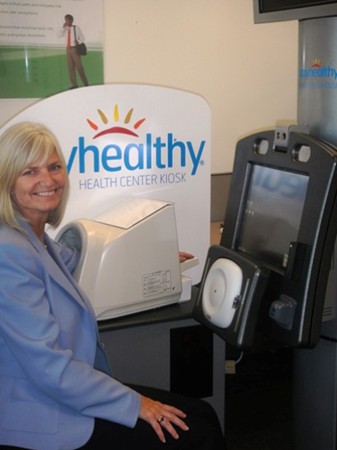In many of Canada’s larger hospitals, more than 1,000 patients visit the emergency department each day.
Approximately 50 per cent of them are considered “low risk” — not needing immediate attention from a physician.
“The wait time for these individuals at emergency can be anything from four to six hours,” noted Luc Villeneuve, president of Mississauga, Ont.-based NCR Canada Ltd.. He said his firm has worked long and hard to create technologies that help such patients get the care they need quickly.
SEE VIDEO: Self-service kiosks mark new milestone in healthcare
Self-service with a smile
The fruit of these efforts, he said, is a new self-service system for healthcare that NCR Canada has ushered into the Canadian market, in partnership with Oakville, Ont.–based Pharma Trust.
RELATED ARTICLES
8 cool BlackBerry apps for medical professionals and their patients
SaaS-tainable healthcare – Cutting down on admin to focus on care
Growing up Grossi — interview with Mark Grossi, chief technology officer, NCR
At the heart of the system, Villeneuve said, are three kiosks that walk low-risk patients, step by step, through the entire cycle of healthcare. “This includes check in, diagnostics, running preliminary tests, as well an online consultation with a physician. After that the patient could have their drugs dispensed to them immediately through another kiosk.”

“And it takes just 30 minutes or so to complete the entire procedure,” the NCR Canada president said. “We believe [these kiosks] can slash wait times for patients by as much as 75 per cent.”
The new system was created in response to consumer demand, noted another NCR executive.
“A survey commissioned by us earlier this year revealed that 70 per cent of consumers prefer a doctor or healthcare provider who offers self-service technology,” said Nelson Gomez, vice-president, NCR Healthcare Solutions headquartered in Duluth, GA.
The online survey done by New York-based BuzzBack Market Research LLC in March 2010, polled more than 4,570 respondents in nine countries — Canada, the U.S., Britain, Brazil, India, China, Italy, Germany and Australia.
While consumers are clamouring for self-service, Gomez rued that few healthcare facilities meet that need.
“In fact the consumer experience in healthcare hasn’t changed much at all over the past 50 years,” he said. “Today when you walk into a physician’s office or a clinic, you’ll still be handed a clipboard and be asked to fill out [paper-based] forms.”
NCR’s new self-service kiosks, he said, take the patients’ experience to a completely different level, enabling them to perform certain tasks quickly and easily.
Self-service technology enhances the consumer experience wherever it’s used, said Gomez. He recalled how years ago, NCR had successfully introduced self-service kiosks into the banking space, and subsequently in the air travel and retail markets. “The next part of that journey is healthcare.”
At a press event Tuesday, Gomez demoed Medikiosk, a patient registration system based on NCR technology.
Three channels, one ‘awesome’ experience
Patients can use the system across at three self-service channels, he said.
“Firstly, you could pre-register online through our portal. The second channel is the kiosk at the point of service, where you could finalize registration, electronically filling in and signing all necessary forms and documents to check yourself in.”
He said the third channel – mobile – could provide patients with a range of text messages relating to their healthcare, such as appointment reminders, lab results and so on.
Gomez demoed how the medikiosk system would work in a healthcare facility. “The first thing you’d do at the office is scan your health card at the machine. The system would authenticate you by asking you a basic qualifying question. After verification, it would then query you about the reason for your visit.”
He said if a patient needed to do a test, such as a CT scan, it would ask whether they had doctor’s requisition. “Then it will ask you to verify a bunch of facts – patient info, spousal info, emergency contact data — and so on.”
All through the self-registration process, he said, the patient can make modifications and edit their information.
The kiosk then walks the patient through their rights and responsibilities, providing electronically the same forms available today in paper-based format. “We have a product that moves those forms electronically and graphically represents them, so the doctor can see them on their [electronic] clip board.”
Finally a ”consent for treatment” form is displayed, which the patient can sign right on the screen. “When you hit Next, you’re given the ability to pay by swiping your credit card.”
Gomez said in Canada the payment option screen would come up only the procedure isn’t covered by OHIP – such as an elective or cosmetic surgery. “If it’s covered, the process would end on a screen which asks you for feedback on your experience.”
While patients have their own user interface, the “activity monitor” provides a staff-facing view of the patient experience.
“Picture a clinic or physician’s office with multiple kiosks checking in patients,” said Gomez. “Healthcare staff would have their own interface offering them an a view of patients’ experience at every single kiosk.”
This system, the NCR exec said, can be implemented to track the entire range of patient transactions, from check in, to the exam room to tests — such as a CT scan, as well as the check-out process. During each step of the process, he said, the transaction is date- and time-stamped.
“These kiosks reduce administrative costs, while driving efficiencies through the system. They help physicians understand where the bottlenecks are and how effective they themselves are in managing the patient experience.”
These self-service kiosks play a tremendous role in helping hospital emergency rooms deal with wait times, according to PharmaTrust CEO and co-founder Don Waugh, who was also present at the press event.

One main objective of the NCR-PharmaTrust alliance, he said, is to help emergency departments deal with wait times.
In Ontario, Waugh noted, around 48 per cent of emergency room visits are classified as 4s and 5s on the Canadian Triage and Acuity Scale (CTAS).
These are non-urgent complaints. “CTAS 4 ailments could be migraines, for intance. These are people who show up in emergency when they could have been dealt with at a walk-in clinic or at a doctor’s office.”
To comprehensively handle their needs, while freeing up scarce emergency department resources NCR and PharmaTrust have developed a set of three self-service kiosks. The first is a self-service patient check in and self-assessment kiosk described earlier.
When patients finish with that, they can pass on to the stayhealthy kiosk, which captures their vital signs. “It’s just like when you visit an emergency department and a nurse checks your temperature, pressure and heart rate. This device does all that and more,” Waugh said.
With the data, he said, the patient moves on to a third kiosk, which is a combination telepharmacy and counselling centre.
“This centre can be in the emergency department, or it can be in a facility such as ours in Oakville, where the physician can provide healthcare remotely –– interviewing the patient, diagnosing their situation and prescribing.”
Helping you find your way
Gomez also demoed an NCR app that helps visitors and patients to large hospitals find their way around.
Getting to from point A to point B at some of the sprawling healthcare campuses can be quite a challenge, what with their multiple wings and floors.
He said the new Wayfinding app from NCR is the antidote to this problem as it enables people navigate to their destination more easily.
“Again it enhances the patient experience,” Gomez said. “The point of entry could actually be their home. We’ve extended the capability of this app through Google Maps to help the patient go from home to hospital, and from there to the specific location within the facility.”
Gomez demonstrated how the app could help a visitor to outpatient wing of the hospital get to the “nail clinic.”
“As the system is location aware it will precisely map the route from where I am to the department I need to get to. The nail clinic may be on a different floor. In which case, it will show me where the elevators are, and the route after I step out of the elevator to my specific destination.”
Gomez noted that each day roughly 10 – 15 minutes of each staff person’s time at a health facility is expended on providing directions to patients. “This app leads to significant productivity gains for staff and adds value to the patient experience.”




